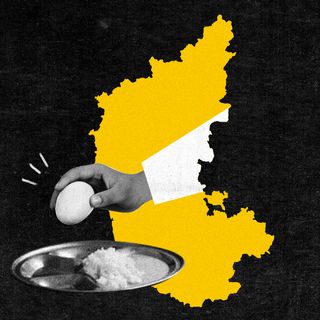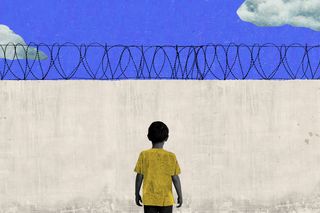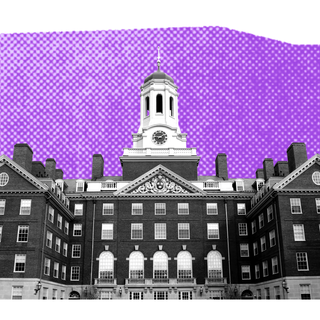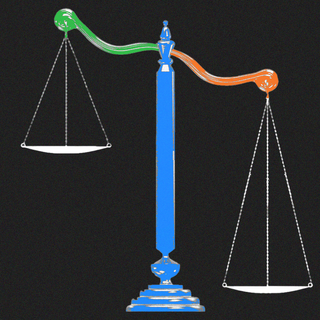
In India’s Juvenile System, Children Are Criminalized for Their Circumstances
Instead of understanding children’s backgrounds and needs, juvenile detention centers blur the line between committing violence and fleeing violence.

The Government Observation Home for Boys and Girls, Kelly’s, in Chennai is a labyrinthine complex, housing row after row of rooms that are locked from the outside. The walls are covered in bright, colorful paintings of flowers, rainbows, and butterflies. From the grilles, there are around 4-5 boys visible in each, either sitting listlessly, or bent over a little notebook, concentrating hard on drawing. Many look quite young, but are officially listed as 16 to 17 years of age.
“I am supposed to go home now. But nobody is coming forward for my surety,” says Chandra*, a 17 year old who was booked under shop theft.
“I was booked under Section 302, for murder, along with three others. But we didn’t do anything — we were merely there, but the police saw us on CCTV and caught us,” says Kumar*, another 17 year-old, who expects to leave the home in the following week if somebody comes back for him.
The Assistant Superintendent explains that by law, two people are required to come forward to give surety for children who receive bail in order for them to be released. While one can be a family member, the other has to be a non-blood relative. Finding someone in the latter category, however, is hard — most people are unwilling to be associated with the children, for fear of the implications it would have on them. As a result, many remain in the observation home — meant to house undertrial children — for months after they have received their bail.
“Society is looking at these kids as criminals,” says Sachi Maniar, director of the Ashiana Foundation, an organization that works with children at risk to help them reintegrate into society. According to her, we cannot look at the juvenile justice system without first reflecting on our own values as a society, and what we stand for.
Asha Mukundan, assistant professor at the Centre for Criminology and Justice, Tata Institute for Social Sciences, Mumbai, works very closely with children in conflict with the law (CCL). Her work resulted in the juvenile justice system making several strides in terms of acknowledging the lack of wherewithal for rehabilitating children.
Post 2012, however, she and others like her found themselves almost back to square one. A big reason was the new narrative that was framed around children who commit crimes. The country was overwrought by shock, outrage, and helplessness at the brutal gangrape of a paramedical student in the national capital. One of the main perpetrators of the heinous crime, a 17-year-old was one of the few whom many felt got away too lightly and represented all that was wrong with the system.
Soon enough, concerned members of the moral majority set their sights on the juvenile justice system. People wanted harsher punishments, more discipline, and no mercy. Consequently, the law lowered the juvenile age from 18 to 16 for heinous offences.
“We were making a lot of progress with community-based rehabilitation, but the Nirbhaya incident in 2012 changed everything. Communities became closed off and were no longer tolerant about “these” children… Even individuals in the system — the police, judiciary — became more vocal about being more strict with this group of children.”
Why people who are so young commit such acts of violence, and what this says about our society, are far more uncomfortable questions to ask. What’s more, the incident cemented the idea in the national psyche that all children who commit crimes are deviant, violent, and irreparable. But a look inside juvenile homes shows a very different story.
A Thin Legal Line
In the Observation Home at Kelly’s, is a single girl of sixteen years. At least that’s what her records say — although she looks far younger. She lives in the girls’ wing of the home all by herself, the sole resident with a matron as her only companion. There is a blankness in her stare as she says that she likes the home. She is there for allegedly stealing a mobile phone from the railway station, where she was publicly caught and hauled off by the police. Her father is not present in her life, and her mother lives on the streets, suffering from addiction, she tells me matter-of-factly.
In most situations, children are victims of their circumstances more than they are perpetrators of crime; once institutionalized, however, these backgrounds are rendered irrelevant.
Related on The Swaddle:
Court‑Ordered Audit of Shelter Homes Paints Bleak Picture
The resources they can access depends on how they are categorized by law. The Juvenile Justice (Care and Protection of Children) Act, 2015, divides children in need of institutional care into two categories: children in conflict with law (CCL) and children in need of care and protection (CNCP). While CNCP receive a lot more care, attention, effort, and sympathy, CCL don’t as much. Children under both categories come from similar circumstances — poverty, violence, and indeed the violence of poverty. But what happens to them and how various actors, like the state, NGOs, and society in general, view them is a function of what they do and whether the law designates it a crime.
Some children are led into committing petty offences, with steep costs, as compared to their non-criminalized CNCP counterparts. Turning to petty theft is a way of surviving the harsh realities of poverty for many children.
A child who consumes drugs, for instance, might also be categorised as “in conflict with the law.” But it is a legal distinction that precludes them from instead being in the subjective category of being in “need of care and protection.” Who is to say they don’t?
The girl in the observation home is someone clearly in need of care and protection.
The Data Disappoints
Children in conflict with law, Mukundan says, are the most invisibilized population that the state deals with. “There is no data on how many children are caught under petty, heinous, or serious offences… In the news you will hear one heinous offence which is very gruesome in nature, and it will completely overpower everybody’s mind, and people think this is what the situation is like,” she adds.
As a result, laws are made and amended on the basis of high-profile cases, which tend to criminalize children even further — with no data to substantiate the extent of the problem in reality.
Many estimations about state-wise differences in the system and how many children come in for what types of crimes, however, are just that — estimations. “Nobody has data. We are working with virtually zero data,” Mukundan explains.
Further, there is no research on the issue across India, and much of the discourse and lawmaking is based on knee-jerk, emotional reaction to incidents shown in the media, without understanding the system’s wherewithal to provide support or protection.
There are four dimensions to the problem, according to Mukundan. “Lack of political will, manpower, funds, and infrastructure.”
The non-availability of data speaks to a greater systemic indifference to children who are considered doomed from the get go. Further, the lack of information exchange even within the system means that it is left to individual magistrates and other people in power to make decisions that would temporarily solve these problems on an ad hoc basis. Meanwhile, children are left in the lurch, unable to receive even the basic care they are entitled under the law.
On ‘Rehabilitation’
The Juvenile Justice Act is primarily focused on rehabilitation. But in the absence of a robust, holistic rehabilitation system, the metrics for defining this rehabilitation are flawed as can be.
“The counselors just come and say a few words now and then, such as ‘don’t do this again’. It doesn’t make a difference to any of us — in fact, many don’t like it,” Akash*, a 15 year-old boy residing in the home, tells me. As far as mental health care goes, the children are not treated, but rather, evaluated for criminality every once in a while — the results of such tests have a bearing on whether they get bail or not.
Even within observation or special homes, guards, counsellors, or provisional officers are hardly trained to the extent that they should be. In many states, observation homes are severely understaffed, which adds to the problem. There is approximately one probation officer for every 500 children, who perform the work of absent rehabilitation officers according to experts. When I spoke to the former superintendent of the Children’s Home in Dongri, Maharashtra, he mentioned that officers are trained to the extent that the law states. But on the question of what exactly this training entailed, he wasn’t forthcoming.
All this leads to a situation where a lack of adequate care and attention for children who commit crimes means that when they inevitably show no progress, the tag of a criminal beyond redemption is attached to them permanently. This has real consequences — life imprisonment or ten to twenty years in adult prison at minimum, says Maniar.
I met a 14-year-old boy in the drawing room, where he lay stretched out on the floor, drawing butterflies in his personal notebook full of similar artwork. He is accompanied by two others who are similarly engaged. While telling me about himself and why he is here, he grins sheepishly while blandly stating: “I got into a drunken fight, and killed someone.”
Rather than receiving the mental health and rehabilitative care he needs, however, he and many like him are kept occupied through drawing, band practice, tailoring, and other vocational training activities. The focus is on making children “productive” members of society, rather than addressing why they ended up here in the first place.
“When [these children] step out, they’re going back into the same community, same families, same social structure that they came from, that may have actually been the key element in making them have to do the crime,” Maniar explains.
Related on The Swaddle:
Govt Should Learn From Nirbhaya Case, Enact Stringent Rape Laws for Juveniles: Madhya Pradesh HC
Building a bridge between “inside” and “outside” thus becomes extremely important. But there are the intangible aspects of rehabilitation beyond vocational training and education that get ignored — emotional and mental health and social support.
However, “in India, most people — forget children, even adults — don’t have basic social emotional skills. So how do we build on children’s social and emotional skills? How do we then work on mental health? How do we constantly enable them, teach them how to reflect on their actions, and look at the consequences?” asks Sachi Maniar.
The lack of even the most rudimentary forms of support if there is no NGO to step in mean that there is an increased chance of recidivism.
“If we do not look at this population as a special population that needs special attention and staff that is trained in trauma-informed practices, then we are going to be in that cycle of criminalising, stigmatising… we’re not offering basic services to them. So how do we expect that anything’s going to change?” Maniar adds.
Criminal Children Or Criminalized Children?
The cycle of neglect these children come from continues even under the care of the state for children in conflict with the law, whose personhood is defined in terms of their crimes alone.
The experience leads to a further deterioration of mental health for many — what some psychiatrists working in the space called “remand home syndrome.”
Maniar recalls an incident in which around 20 children were “caught” copying in their board examinations based on flimsy evidence. The police “nabbed” the children in a manner that they would to hardened criminals — going into their parents’ houses in the middle of the night, threatening their friends, and so on. Although most got bail, they were barred from the examination for three years — a fact that Maniar says traumatized them, along with the experience of it all. Similar incidents have all led to a situation in which children are left with traumatic experiences that hamper their successful reintegration into society.
Instead, she says, if they “start looking at you as somebody who believes in them, then there are very, very minor chances of them letting you down.”
Addiction is another vast problem where a lack of infrastructure means that rather than receiving treatment and support, children are once again criminalized due to petty offences they might have committed somewhere in the cycle of addiction. There are little to no de-addiction centers in the country that might help.
Further, children — mostly boys — are also chargesheeted under Protection of Children from Sexual Offences (POCSO) Act cases, in which consensual sex between two minors who have eloped is criminalized.
It is thus evident that the definition of what constitutes a criminal in people’s minds is deeply tied to morality and social standing. The lack of support for these children is almost deliberate — based on a moral judgement of whether they “deserve” it or not. “There are no organisations that are working with children in conflict with law… NGOs find it very difficult to work because there are no funding agencies ready to fund a population which is related to conflict with law… So these children are completely left to themselves.” Mukundan says.
Education, protection from child abuse, and other areas of child rights recieve funding on a comparatively much larger scale, according to her.
“The easy way out is to lock them in a room,” Mukundan adds. Rather than receiving care and support, children are treated as prisoners and the institutional approach is consequently security-based, rather than rehabilitative, where the focus is on ensuring that the children don’t “escape.” This leads to a host of behavioral problems.
“We are kept locked in a room all day. There are 6-7 of us in each room, which makes it suffocating and tense. I get so bored, but we are allowed out only for mealtimes and some occasional games. It is very difficult to live here,” Akash* tells me.
Surya*, 17, is part of a group of four children arrested under murder charges. He had just been outside for Diwali, when he unexpectedly got caught up in the incident that brought him here. It only takes a question about what it is that children want, to get to the heart of what needs to be done. “I just want to go home. My family is struggling. If I’m out, I can continue my education and training and support them. I was never meant to end up here,” he says.
Ultimately, systemic apathy from all fronts leads to a self-fulfilling prophecy in which criminalized children are destined to become “criminals” — at least in the eyes of society. “People feel there’s so much of violence happening, ‘these boys are like this only’ — no, they’re not ‘like this’! What options are you giving them?” asks Mukundan. And this, at the end of the day, is the question that the system needs to ask itself.
* Names changed for anonymity and legal purposes.
Rohitha Naraharisetty is a Senior Associate Editor at The Swaddle. She writes about the intersection of gender, caste, social movements, and pop culture. She can be found on Instagram at @rohitha_97 or on Twitter at @romimacaronii.
Related


Harvard University Recognizes Caste‑Based Discrimination, Includes Caste Under ‘Protected’ Category
